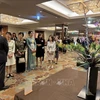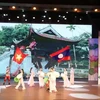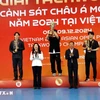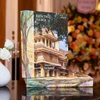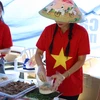Hanoi authorities are restoring 82 stone tablets recording the royal examinations held under the Le-Mac dynasties (1442-1779) placed at Van Mieu (the Temple of Literature) and Quoc Tu Giam (Vietnam’s first national university).
The move is to promote the historical and cultural values of the tablets, declared a UNESCO world documentary heritage in 2010 and recently received recognition as a “national treasure” by the Prime Minister.
The steles were designed in the form of a tortoise-mounted tablet, eliciting the traditional symbol of longevity in Vietnamese culture.
Nguyen Thi Luan, Deputy Director of the relic site’s scientific and cultural activities centre, said the city will complete the restoration of the shelters, including pillars and roofs, ahead of the traditional Lunar New Year (Tet).
The centre will work with relevant agencies to design and carry out a project conserving the tablets, covering the full collection of scientific data on the 82 tablets and enacting measures to promote their values.
If approved, the project will be carried out between 2015 and 2020.
To preserve the steles, the centre built fences to prevent visitors from touching the tortoises’ heads. In 1994, new shelters were rebuilt to limit the wear of the steles due to weather and natural erosion.
Van Mieu – Quoc Tu Giam (Temple of Literature – The First University of Vietnam) was established in 1070-1076 under the Ly Dynasty (1010-1225). After many royal examinations, in 1482 King Le Thanh Tong (who reigned from 1460 to 1497) ordered the erection of stone steles inscribed with the names and native lands of the first laureates of the royal examinations since the royal examinations began in 1442.
Between 1442 and 1779, 124 doctoral examinations were held but now only 82 stone steles are preserved in Van Mieu – Quoc Tu Giam. The steles are placed on the back of stone turtles, the symbol of the immortality of the national quintessence.
The 82 stone steles have a great value of sculpture and calligraphy. All of them were carved from stone in Dong Son, Thanh Hoa province by artisans in Hong Luc and Lieu Chang villages in Kinh Mon district, Hai Duong province which is famous nationwide for the craft of making wood-blocks and inscribing on stele.
The steles with epitaphs which were composed by cultural celebrities and bright scholars of the country can be seen as pieces of art and are considered as “stone history sets” about Vietnam’s Confucian education. The inscriptions of these steles are standard Chinese verses and lines with the type of parallel construction, which are remarkable pieces of literature and valuable in terms of art and ideology.-VNA
The move is to promote the historical and cultural values of the tablets, declared a UNESCO world documentary heritage in 2010 and recently received recognition as a “national treasure” by the Prime Minister.
The steles were designed in the form of a tortoise-mounted tablet, eliciting the traditional symbol of longevity in Vietnamese culture.
Nguyen Thi Luan, Deputy Director of the relic site’s scientific and cultural activities centre, said the city will complete the restoration of the shelters, including pillars and roofs, ahead of the traditional Lunar New Year (Tet).
The centre will work with relevant agencies to design and carry out a project conserving the tablets, covering the full collection of scientific data on the 82 tablets and enacting measures to promote their values.
If approved, the project will be carried out between 2015 and 2020.
To preserve the steles, the centre built fences to prevent visitors from touching the tortoises’ heads. In 1994, new shelters were rebuilt to limit the wear of the steles due to weather and natural erosion.
Van Mieu – Quoc Tu Giam (Temple of Literature – The First University of Vietnam) was established in 1070-1076 under the Ly Dynasty (1010-1225). After many royal examinations, in 1482 King Le Thanh Tong (who reigned from 1460 to 1497) ordered the erection of stone steles inscribed with the names and native lands of the first laureates of the royal examinations since the royal examinations began in 1442.
Between 1442 and 1779, 124 doctoral examinations were held but now only 82 stone steles are preserved in Van Mieu – Quoc Tu Giam. The steles are placed on the back of stone turtles, the symbol of the immortality of the national quintessence.
The 82 stone steles have a great value of sculpture and calligraphy. All of them were carved from stone in Dong Son, Thanh Hoa province by artisans in Hong Luc and Lieu Chang villages in Kinh Mon district, Hai Duong province which is famous nationwide for the craft of making wood-blocks and inscribing on stele.
The steles with epitaphs which were composed by cultural celebrities and bright scholars of the country can be seen as pieces of art and are considered as “stone history sets” about Vietnam’s Confucian education. The inscriptions of these steles are standard Chinese verses and lines with the type of parallel construction, which are remarkable pieces of literature and valuable in terms of art and ideology.-VNA






